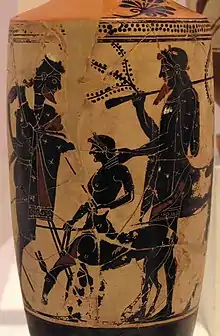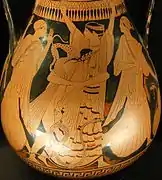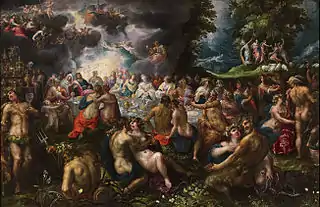Peleus
In Greek mythology, Peleus (/ˈpiːliəs, ˈpiːljuːs/; Ancient Greek: Πηλεύς Pēleus) was a hero, king of Phthia, husband of Thetis and the father of their son Achilles. This myth was already known to the hearers of Homer in the late 8th century BC.[1]

Biography
Peleus was the son of Aeacus, king of the island of Aegina,[2] and Endeïs, the oread of Mount Pelion in Thessaly.[3] He married the sea-nymph Thetis with whom he fathered Achilles.
Peleus and his brother Telamon were friends of Heracles, and served in Heracles' expedition against the Amazons, his war against King Laomedon, and his quest for the Golden Fleece alongside Jason and the Argonauts. Though there were no further kings in Aegina, the kings of Epirus claimed descent from Peleus in the historic period.[4]
Mythology
Peleus and his brother Telamon killed their half-brother Phocus, perhaps in a hunting accident and certainly in an unthinking moment,[5] and fled Aegina to escape punishment. In Phthia, Peleus was purified by the city's ruler, Eurytion, and then married the latter's daughter, Antigone, by whom he had a daughter, Polydora. Eurytion received the barest mention among the Argonauts (both Peleus and Telamon were Argonauts themselves) "yet not together, nor from one place, for they dwelt far apart and distant from Aigina;"[6] but Peleus accidentally killed Eurytion during the hunt for the Calydonian Boar and fled from Phthia.
Peleus was purified of the murder of Eurytion in Iolcus by Acastus. Acastus' wife, Astydameia, fell in love with Peleus and after he scorned her, she sent a messenger to Antigone to tell her that Peleus was to marry Acastus' daughter. As a result, Antigone hanged herself.
Astydameia then told Acastus that Peleus had tried to rape her. Acastus took Peleus on a hunting trip atop Mount Pelion and once Peleus fell asleep, Acastus hid his sword away and abandoned him on the mountainside. Peleus woke up and as a group of centaurs was about to attack him, the wise centaur Chiron, or, according to another source, Hermes, returned his sword to him and Peleus managed to escape.[7] He pillaged Iolcus and dismembered Astydameia, then marched his army between the rended limbs. Acastus and Astydamia were dead and the kingdom fell to Jason's son, Thessalus.
Marriage to Thetis

After Antigone's death, Peleus married the sea-nymph Thetis. He was able to win her over with the aid of Proteus, who instructed Peleus to hold onto her tightly through all of her physical transformations she used to try to escape.[8] Their wedding feast was attended by many of the Olympian gods. As wedding presents, the Poseidon gave Peleus two immortal horses: Balius and Xanthus, Hephaestus gave him a knife, Aphrodite a bowl with an embossed Eros, Hera a chlamys, Athena a flute, Nereus a basket of the divine salt which has an irresistible virtue for overeating, appetite and digestion and Zeus gave Thetis, as present, the wings of Arke.[9][10]
During the feast, Eris, in revenge for not being invited, produced the Apple of Discord, which started the quarrel that led to the Judgement of Paris and eventually the Trojan War. The marriage of Peleus and Thetis produced seven sons, six of whom died in infancy. The only surviving son was Achilles.
Peleus' son Achilles
Thetis attempted to render her son Achilles invulnerable. In the well-known version, she dipped him in the River Styx, holding him by one heel, which remained vulnerable. In an early and less popular version of the story, Thetis anointed the boy in ambrosia and put him on top of a fire to burn away the mortal parts of his body. She was interrupted by Peleus and she abandoned both father and son in a rage, leaving his heel vulnerable. A nearly identical story is told by Plutarch, in his On Isis and Osiris, of the goddess Isis burning away the mortality of Prince Maneros of Byblos, son of Queen Astarte, and being likewise interrupted before completing the process. Later on in life, Achilles is killed by Paris when he is shot in his vulnerable spot, the heel. This is where the term "Achilles' heel" is derived from.
Peleus gave Achilles to the centaur Chiron, to raise on Mt. Pelion, which took its name from Peleus.
In the Iliad, Achilles uses Peleus' immortal horses and also wields his father's spear.
In hero-cult
Though the tomb of Aeacus remained in a shrine enclosure in the most conspicuous part of the port city, a quadrangular enclosure of white marble sculpted with bas-reliefs, in the form in which Pausanias saw it, with the tumulus of Phocus nearby,[11] there was no temenos of Peleus at Aegina. Two versions of Peleus' fate account for this; in Euripides' Troades, Acastus, son of Pelias, has exiled him from Phthia;[12] and subsequently he dies in exile; in another, he is reunited with Thetis and made immortal.
In antiquity, according to a fragment of Callimachus' lost Aitia,[13] there was a tomb of Peleus in Ikos (modern Alonissos), an island of the northern Sporades; there Peleus was venerated as "king of the Myrmidons" and the "return of the hero" was celebrated annually.[14] And there was his tomb, according to a poem in the Greek Anthology.[15]
The only other reference to veneration of Peleus comes from the Christian Clement of Alexandria, in his polemical Exhortation to the Greeks. Clement attributes his source to a "collection of marvels" by a certain "Monimos" of whom nothing is known, and claims, in pursuit of his thesis that daimon-worshipers become as cruel as their gods, that in "Pella of Thessaly human sacrifice is offered to Peleus and Cheiron, the victim being an Achaean".[16] Of this, the continuing association of Peleus and Chiron is the most dependable detail.[17]
In Athenian tragedy
A Peleus by Sophocles is lost. He appears as a character in Euripides' tragedy Andromache (c. 425 BC).
Gallery
Peleus and Thetis
Wedding of Peleus and Thetis
Notes
- Peleus is mentioned in Homer's Odyssey during the conversation between Odysseus and the dead Achilles.
- The island lies in the Saronic Gulf opposite the coast of Epidaurus; it had once been called Oenone, Pausanias was informed.
- In poetry he and Telamon are sometimes the Endeides, the "sons of Endeis"; see, for example, Pausanias 2.29.10.
- Pausanias, 2.29.4.
- "A witless moment" (Apollonius, Argonautica, I. 93,
- Apollonius of Rhodes, Argonautica I.90-93, in Peter Green's translation (2007:45).
- Aristophanes, The Clouds, 1063-1067.
- Ovid, Metamorphoses, XI 219-74.
- Photius, Bibliotheca excerpts - GR
- Photius, Bibliotheca excerpts, 190.46 - EN
- Pausanias, 2.29.6-7
- Scholia on Euripides, Troades 1123-28 note that in some accounts the sons of Acastus have cast him out, and that he was received by Molon in his exile
- One of the fragmentary Oxyrhynchus papyri, noted by Lewis Richard Farnell, Greek Hero Cults and Ideas of Immortality: the Gifford Lectures, "The Cults of Epic Heroes: Peleus" 1921:310f.
- Farnell 1921:310f; Farnell remarks on "some ethnic tradition that escapes us, but which led the inhabitants to attach the name of Peleus to some forgotten grave," so deep was the cultural discontinuity between Mycenaean Greece and the rise of hero-cults in the 8th century BC.
- Greek Anthology, 7.2.
- George William Butterworth, ed. and tr.Clement of Alexandria, "Exhortation to the Greeks" 1919:93.
- By way of apology for Clement, Farnell suggests "human sacrifice was occasionally an adjunct of hero-cults, and this at Pella may have been an exceptional rite prescribed at a crisis by some later oracle." (Farnell 1921:311). Dennis D. Hughes, Human Sacrifice in Ancient Greece (Routledge, 1991) offers a skeptical view of the actuality of human sacrifices during historical times.
References
| Wikimedia Commons has media related to Peleus. |
- Pseudo-Apollodorus, Bibliotheke I, ix, 16 and III, ix,2 and xii, 6- xiii,7; Epitome vi, 13.
- Apollonius Rhodius, Argonautica IV,805- 879
- Ovid, Metamorphoses VIII, 299-381.
- Homer, Iliad XVIII, 78-87;
- Catullus, Poem 64
- Euripides, Andromache.











.jpg.webp)


_-_The_Marriage_Feast_of_Peleus_and_Thetis.jpg.webp)




_-_WGA05246.jpg.webp)
_-_WGA05245.jpg.webp)









